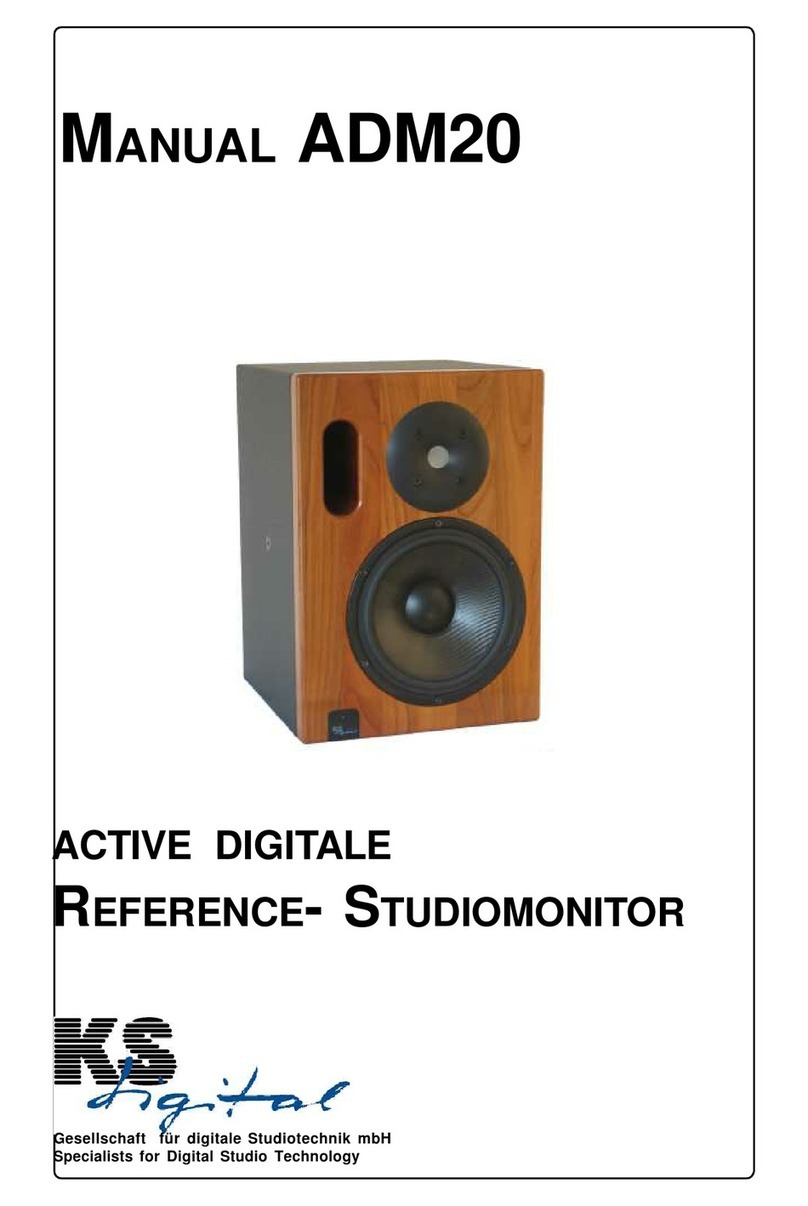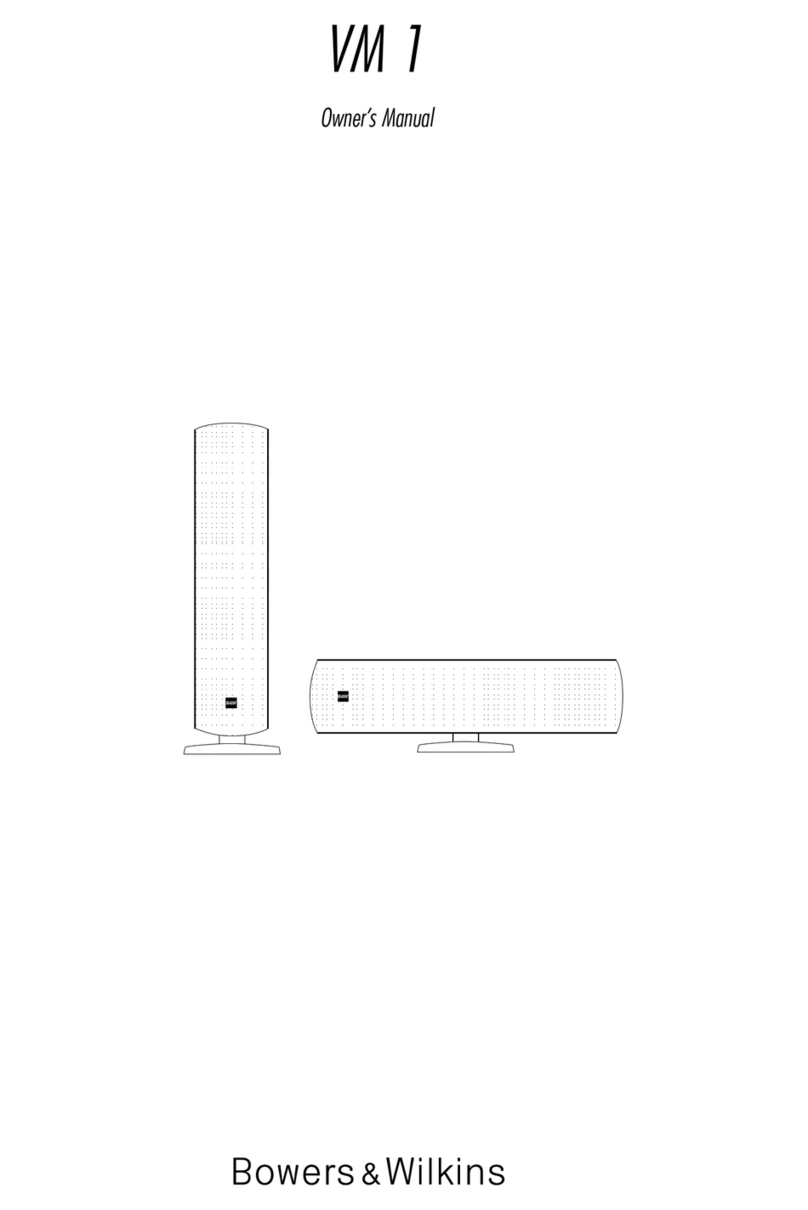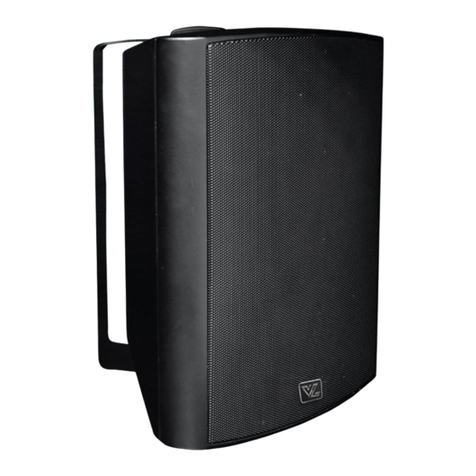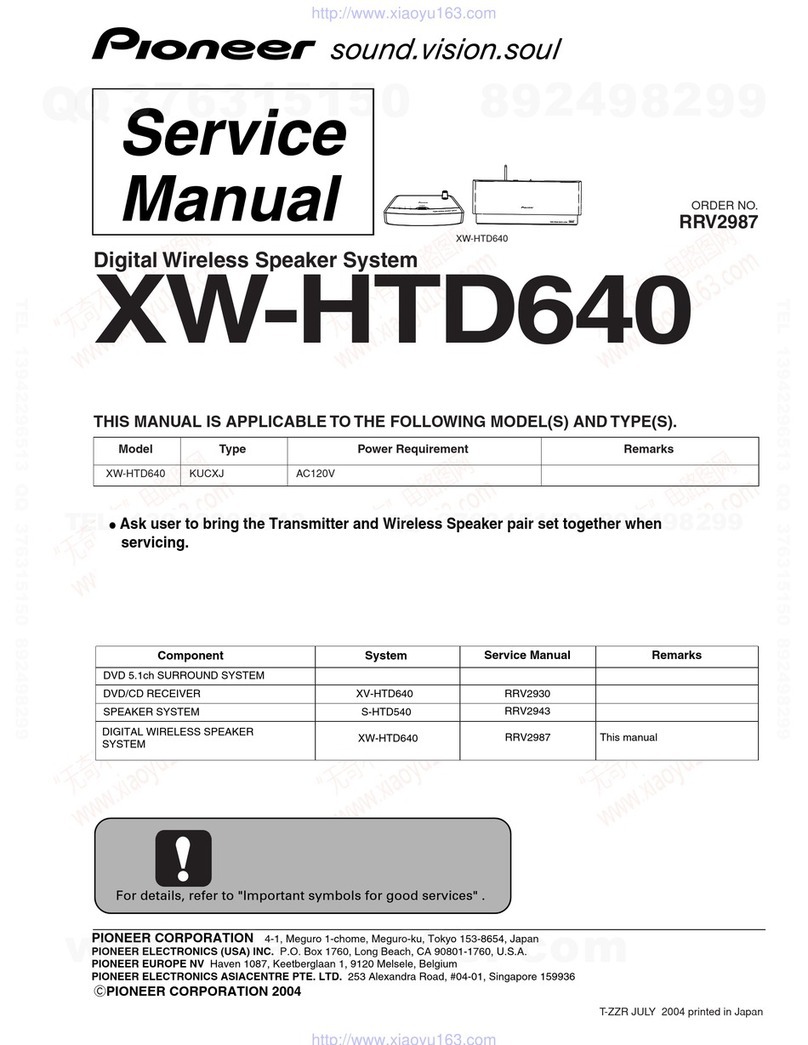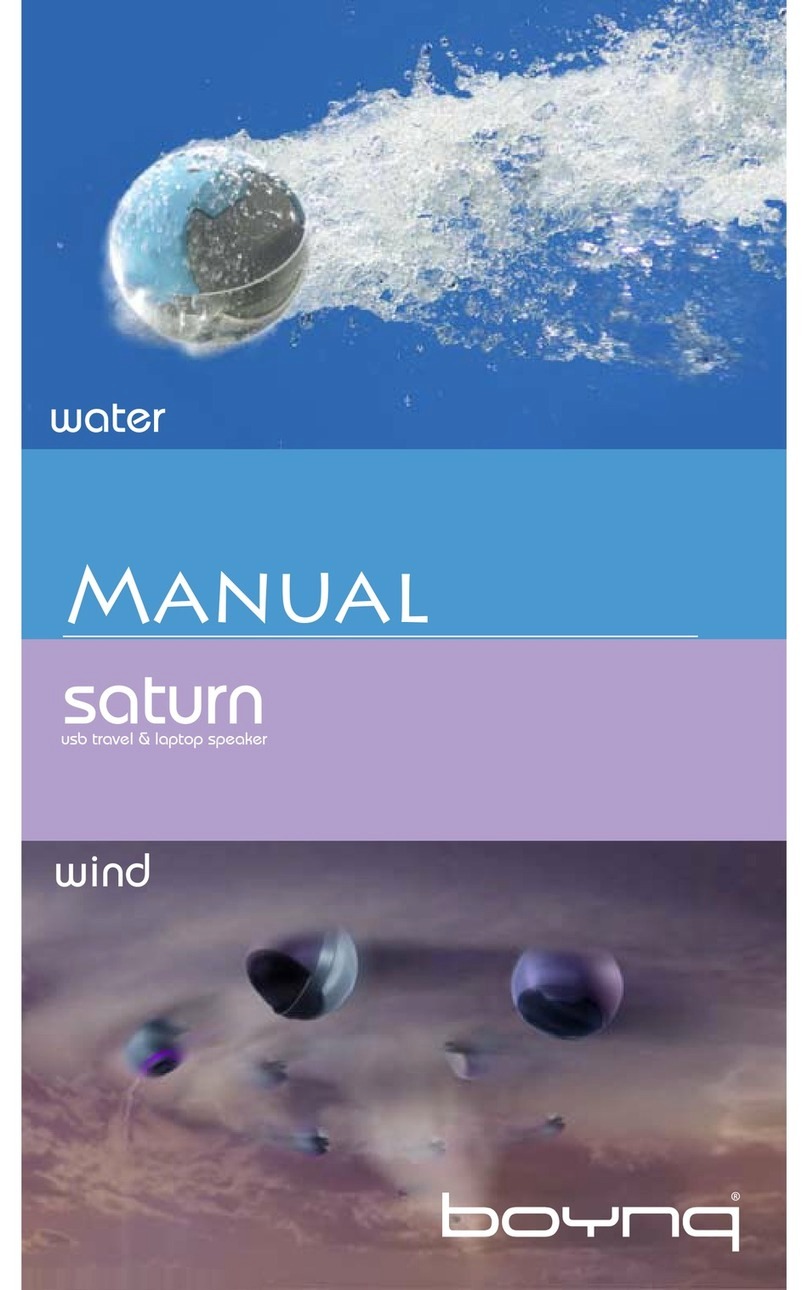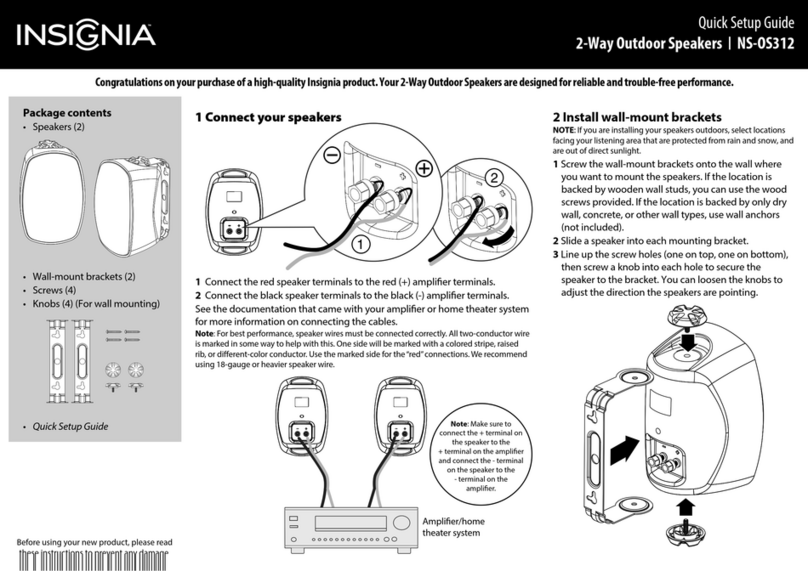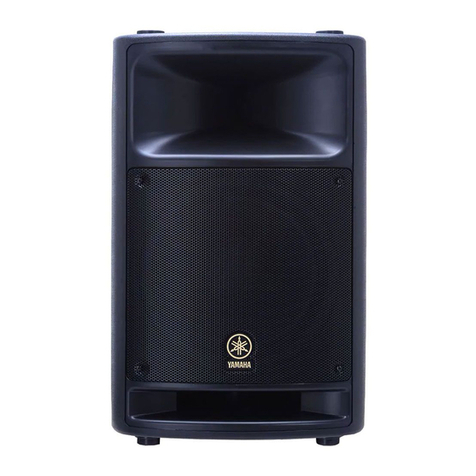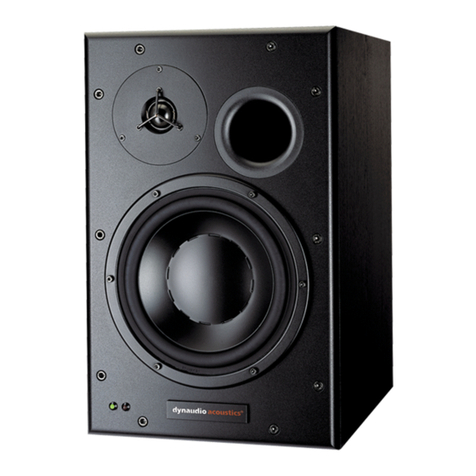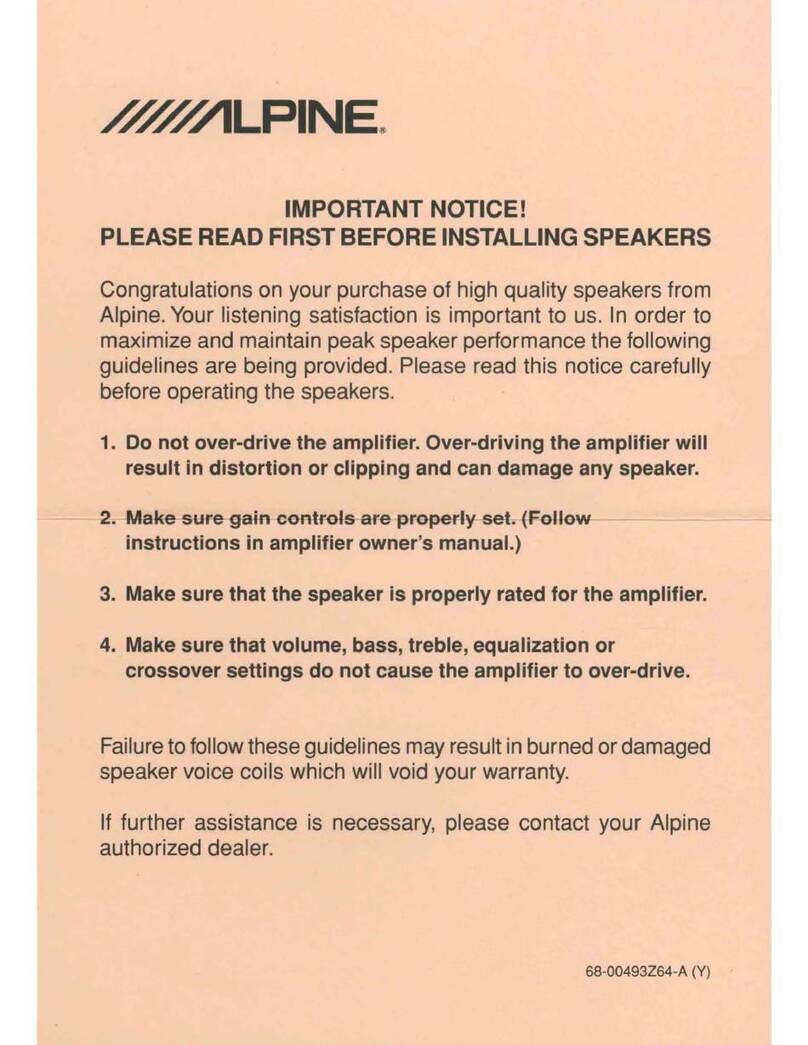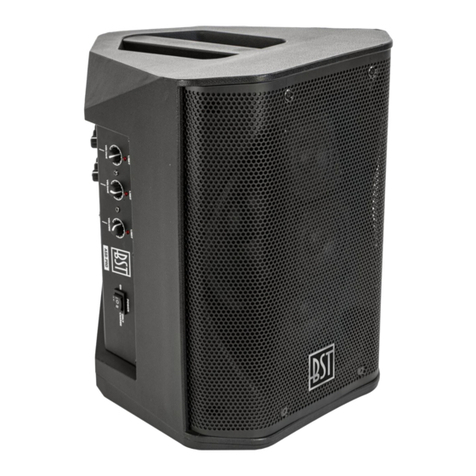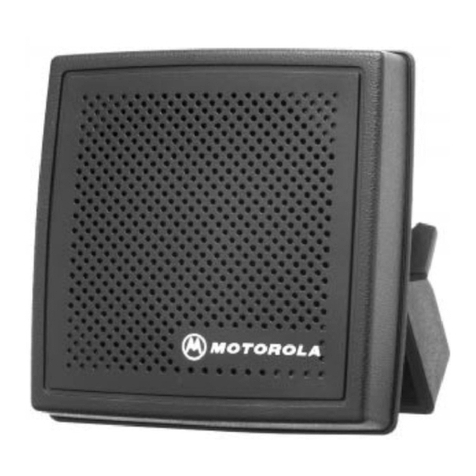KS DIGITAL SAT 3 User manual

The Art of Sound
Handcrafted and Engineered in Germany
1
Manual SAT 3
1 Welcome
We are pleased to welcome you as a new KS Audio product owner. We wish you much fun and success with the
revolutionary and innovative, SAT 3 system. The KS Audio aim has always been to supply the most advanced product
possible for the end user.
KS Audio has evolved because of the end user: the professional sound engineer, musician, producer and rental owner.
Our products are designed to give you a mature tool that will enable everyone to reach their goals faster and with the
highest possible quality. KS Audio end users, through their actual experience, have contributed to each new stage of
development and optimization and thus, we welcome your comments and suggestions as well. Thank you in advance.
Now,to the manual..........
Many words are not our thing. At KS Audio we believe that the SAT 3 will be always easy to use to achieve a great
sound, even without reading the manual. However, at KS Audio we do want you to be fully informed about your new
purchase, and perhaps about new things that will further enlighten your understanding of the meaning of:
“KS, The Art of Sound”.
Wetrust you will find all the information you need and we will be happy to answer any further questions you may
have in the future. The detail in this manual will help you understand the product fully and thus, add to your full
enjoyment of our “Artof Sound”.
KS Beschallungstechnik GmbH - Westendstr. 1 - 67310 Hettenleidelheim - Germany - www.ks-audio.de
KS Audio USA - 1062 Cephas Drive - Clearwater, FL 33765 - USA - www.ksaudiousa.com
05/09

The Art of Sound
Handcrafted and engineered in Germany
2
1Quick Start Guide
1.1 A Brief Description of the SAT 3 system
The SAT 3 is a brand new design, engineered to successfully supersede the long running and successful the KS Audio
product called SAT/SESSION which are compact satellite PA systems. The SAT 3 comprises of two new innovative
functions, they are: FIR control, and HDSP. To expand SPL without adding additional and expensive amplification is
easy.
The SAT 3 is a completely integrated, FIR - DSP controlled, self powered, 2-way compact satellite PA system. The main
field of application is where high quality public address and music reproduction in small to middle sized spaces are
required. For increased sound pressure levels, the CW 18 passive subwoofer can be added. And, even when the quality
of application is challenged by the space, irrespective of the size, the HDSP design of the top boxes, invented by KS
Audio, will produce great results due to the unique use of a varying 60° - 120° angle of dispersion.
1.2 Primary Components of the SAT 3
The SAT3Satellite compact PASystem is supplied as standardwith:
1 x CB 18 bass cabinet containing an 18” sub woofer driver
2 x C 10 top boxes containing a 10" LF-MF driver, a 1" HF driver and the HDSP dispersion horn-wave guide.
1 x 19" rack mount module containing amplification, connections, FIR Control, USB computer connector, and an
integrated automatic power supply unit. This rack unit is fitted into the upper rear of the sub cabinet.
KS Audio invented an expression : “ Plug ‘n Play”, This expression refers very much to the simplicity of the new SAT 3
system.
1.3 Expansion options
The Expansion options are:
A. A passive, 1 x 18” the CW 18 sub bass cabinet which connects as a passive unit to the “ext. woofer” outlet of the
SAT3 control panel.
B. two more C 10 top boxes may be added by linking through from each of the first original top boxes.
1.4 Versatility
Both the CW 18 sub and the C 10 top boxes can be powered by one of the KS Audio power amplifiers such as the CA4S
or the TA4D, containing a dedicated controller card as an alternative to the SAT3 and it’s controller system.
1.5 Ease of Use
The main applications for the SAT 3 system are high quality live music performances in small to medium size venues.
In keeping with other KS Audio Satellite PA systems, operating the SAT 3 system needs no special knowledge as
everything is easy to setup and run, and is already tuned to sound professional, if you take advantage of the PC based
remote control software as well, this will assist you in advanced adjustments of the internal DSP controller, such as
Equalizers, delay times and volume controls.
1.5 Before you start
Please inspect the speaker and any accessories while unpacking the SAT 3 system for possible defects or transport
damages. Damaged devices could endanger yourself and other equipment. When setting up the speakers, you should
point them to the center of the space you want to cover, and if necessary, use a stand or flying frame to elevate the
speaker to a desired height. Please be sure the power switch is turned to the off position and the input level is set to
minimum in order to avoid possible problems. After connecting all power and audio cables for the system, turn on the
SAT3system and increase the input volume to the desired level. Now you are ready to start!

The Art of Sound
Handcrafted and Engineered in Germany
3
2Individual components of the SAT 3
2.1 Drivers
2.1.1 Low Frequency Driver
The 18” LF driver in the SAT 3 currently represents the ideal balance between high strength and high efficiency, with
minimal distortion and maximum excursion. A large 100 mm = 4” flat wire voice coil is pushing an extremely light
and rigid paper cone with high internal damping properties. This is coupled to extremely powerful neodymium
magnets. The SAT 3 operates at a continuous SPL of 133dB/1W/1m from a dedicated MOSFET amplifier in a bridged
channel
output mode, rated at 1200W rms.
2.1.2 Vented Bass Enclosure
An essential role in the production of low frequencies is the acoustic attenuation of a precisely tuned bass reflex type
loudspeaker enclosure. Below a defined cutoff frequency is a significant increase in pressure that restricts the available
diaphragm movement and similarly increases distortion and mechanical stresses. An accurate and in-phase low
frequency reproduction is achieved by an optimal balance between the 18” driver and the cabinet construction itself,
resulting in a flat response and the lowest possible distortion. The special KS triangular bass reflex port design func-
tions for both the exchange of the air for the cooling of the power amps and for low frequency reproduction.
Additionally, the interior walls of the enclosure are lined with a layer of acoustic dampening polyester fiber material.
2.1.3 Mid High C 10 Driver
Asingle 3” coil, 10” diameter membrane driver with a lightweight Neodymium magnet is powered by a 400 watts
RMS amplifier to produce a full frequency band response from a lightweight satellite top box. With little need of
internal air volume behind the driver membrane, the top box dimensions are reduced to give a compact size and low
weight combination.
2.1.4 High Frequency Horn and Wave Guide Assembly
The cylindrical waveguide horn unit is a glass fiber reinforced assembly fitted into the front wall of the cabinet. This
panel is made from a high strength, water resistant birch plywood designed to stop natural vibrations due to high
sound pressurelevels. In addition, the waveguide / hornhandles how the way frequencies above 1.2kHz are disper-
sed. The new HDSP (High Definition Sound Projection) design drastically increases image intelligibility, especially in
areas where strong wall reflections are present. The energy of the high frequency driver is created in a wave-guide to
produce a sound field with varying distances from a vertically bent line, meaning that the sound is radiated from the
hornat120° horizontal by a 30° vertical dispersion in the near field and at only 60° horizontal and a 5° vertical
dispersion in the far field, with an overall 5° down-angle, when the box is level. With an overall angle of coverage
from top to bottom of 35° vertical and no acoustical energy radiated above the top of the cabinet. The result is that
all sound energy is directed in a bent wave front to point downwards towards the audience and not to the walls or
the ceiling, resulting in an
extremely even sound pressure distribution in the width as well as the depth of a room. Thus, by precisely adjusting
the sound field image from within the crossover area between the low frequency driver and the mid/high frequency
driver, the signal is time aligned and phase corrected using FIR Filters so that the inclined main radiation axis is
maintained within a wide frequency range.
The frequency of the high pass filter has been selected so that the image focus resulting from the woofer diameter
corresponds to the image focusing of the middle / high frequency driver to combine the wave fronts for an optimized
and coherent listening area.
The real world results are a reduction in inventory and equipment as well as labor cost for rental corporations and
required installation size and time both for rental and fixed installations. As a result, one C 10 speaker per side
covers the equivalent area of 2 or more other speakers per side, however, the SAT 3 can drive 2 C 10 speakers per side
in a daisy chain format to provide the ultimate in wide and deep coverage.

The Art of Sound
Handcrafted and engineered in Germany
4
2.1.5 High Frequency C 10 Compression Driver
The HF driver in the C 10 currently represents the ideal balance between high strength and high efficiency with a
minimal distortion factor. A single 2” coil with a Mylar ring membrane and a specially designed Phase Plug projects
sound through a 1” mouth opening to a front mounted wave guide. Aided by a built-in passive crossover and the
FIR filter controlled amplifier, KS has achieved a linear transmission behavior up to almost 20 kHz.
2.1.6 Construction Materials
Active audio systems have very high demands placed on them. You can not allow vibrations of the material to color the
sound. There are a lot of heavy and sensitive components that must be kept safe during transport.
To ensure a high standard of sound reproduction, safety of the components, and successful transportation, KS Audio uses
only multi-ply, water resistant, birch plywood at a thickness of between 18 and 22 mm, depending on location.
CNC (Computer Numerical Control) milling and drilling technology is used to guarantee the highest dimensional
accuracy. The joints are crafted to be solid: gluing with tongue and groove joints, as well as bolting or screwing where
necessary. The amplifier chassis uses solid steel rails in a separate section of the cabinet to ensure further reliability. All
detachable connections have metric threads.
2.1.7 Physical Handling
For safe handling, the C 10 speakers arebuilt with solid grip handles. A pole mount in the bottom is also provided for
use on standard1.5” (36 mm) tripod stands. The CB 18 subwoofer has a pole mount on the top with an M20 screw in
connector. These are commonly available accessories. In acoustically difficult situations KS has created a swing frame
with tripod adapter to allow any angle of alignment necessaryfor the C 10. On the bottom, thereare4feet made from a
special abrasion resistant plastic, so they slide easily and are not damaged on rough surfaces. The surfaces of cone drivers
are susceptible to impacts and
moisture, thus a heavy gauge
steel grill with a particularly
fine mesh offers good impact
resistance and high sound
transparency.The foam filter
under the grill provides splash
resistance to further protect
the drivers from the elements.
2.1.8 Cabinet Finishes
Therearetwo available surface
finishes for the cabinet.
Ascuff resistant textured
polyurethane surface coating
in a black color is for heavy
duty touring applications,
whereas, for fixed installati-
ons, and color conscious envi-
ronments where design and
color matching areequally
important, the surface finish
can be pre-selected from a
palette of 200 available colors
to match.

The Art of Sound
Handcrafted and Engineered in Germany
vertical polar patterns
conventional C 10
horizontal polar patterns
conventional C 10
5
2.1.9 Dispersion
HF / MF Dispersion…..
Loudspeakers have a typical dispersion which is
moreor less focused over a broad frequency
spectrum. The goal is to focus the dispersion
directly at the audience in order to attain a high
level of audibility,even when the space
produces large amounts of reflections. Aim the
speakers at the audience to reduce unwanted
reflections.
The C10 is designed to cover a shorter distance
with a balanced and wider dispersion coverage
out and over a rectangular area from a
dispersion of 60° farfield and at the same time a
120° nearfield with a 35° down angle and this is
the incredible result of the new invention cal-
led, HDSP (High Definition Sound Projection), a
new combination wave-guide and horn. The
main dispersion axis is a 5° angle down.
Please aim the C10 speaker horns at the center
of the room and to ear height. In a challenging
environment, this speaker focus method will
yield better results overall.

The Art of Sound
Handcrafted and engineered in Germany
6
2.2 Amplification
2.2.1 Power Amplifiers
The SAT 3 is a fully self-powered system comprising of 6 individual PWM ( see page 15 for details) MOSFET amplifiers.
2amplifiers are bridged (tied) together to drive the 18” sub bass driver.
2amplifiers are bridged (tied) together and held in reserve for when an additional sub bass driver is connected.
2amplifiers are in stereo to drive the left and right passive C10 top boxes.
2.2.2 Power Supply Unit
All heavier internal components such as the power transformer block, are secured and fastened to the internal
structures to resist movement and breaking free due to low frequency vibrations created by the sub bass driver.
The power supply utilizes a separate circuit for the FIR controller module in order to maintain stability independently
of all other power circuits as they draw variable power loads needed to output sound pressure levels whereas, the
digital controllers are computer based systems and need solid continuity of voltage to operate reliability.
The SAT 3 uses a state-of-the-artwide-range heavy duty switch mode power supply (SMPS), with
Power-Factor-Correction (PFC). KS has created a special design and construction to insulate the power supply unit from
the mechanical effects from vibrations generated by the LF driver. A similar independent wide-range heavy-duty switch
mode power supply with PFC is used to supply the controller-electronics. This power supply will accept any AC input
from 96 – 250v ac, 50 / 60Hz. It is connected via a Blue Neutrik PowerCon connector with protective leader.
The controller / amplifier system is properly grounded, for your own safety, please ensure the power circuit you are
plugging into is properly grounded as well. The efficiency of all KS Audio equipment is very high, therefore; the
effective demand for electricity is quite low.
Please be sure that the actual current draw for all speakers on the supply circuit does not exceed the maximum fuse
rating on each speaker. The combination of these design considerations benefit the overall sonic quality of the SAT 3
has an internal auto reset breaker (20 amps @ 117V/60Hz AC) (10 Amps @ 230V/50HzAC) and is not user serviceable.
2.2.3 Cooling System
As the air cooling ventilation exchange system utilizes the same bass reflex ports, these airways should be kept clear at
all times. The SAT 3 is supplied with PWM (Pulse Width Modulation) power amplifiers. In the production of high
output low frequencies, high levels of heat arealso generated as a by-product at the amplifier.The removal of these
high temperatures is done with the installation of a very large heat sink surface to conduct heat away, and thus, the
use of fans is no longer needed, further eliminating all mechanical noise in the immediate surrounding environment.
Additionally,all semiconductor components arekept cooler in the amplifier,which maintains levels of efficient
operation within the system without component breakdowns.
The SAT 3 is voltage regulated to increase efficiency and simultaneously reduce the thermal losses, which also allows
convection cooling as the chosen cooling method.
KS Audio hand selects and goes through an extensive burn-in process for all components to assure precise electrical
symmetrywith minimal current output offset, thus distortion is kept to the minimum along with a high damping
factor.The loudspeaker then produces the best possible impulse wave at its output.
2.2.4 Circuit Protections
1. On power up, the audio outputs aremuted to protect the drivers by a timed-out circuit, and the power transformer
is current-limited to prevent driver damage.
2. Normal levels of current draw are self-monitored by the amplifier for protection.
3. When higher than normal temperatures are detected in the amplifier's heat-sinks, the DSP controller limiters are
activated to reduce signal volume and do so in linear fashion to minimize signal interruptions.
4. At temperatures above 85 C (185 F) the outputs are muted until temperatures reduce to below the 85 C limit.
5. Under normal operating conditions, the DSP controller limiters are continuously monitoring signal levels to reduce
amplifier overheat or driver distortion.

The Art of Sound
Handcrafted and Engineered in Germany
7
2.3 Control Panel Components and Connections
On the back side of the CB 18 sub bass is a 19” 1 unit integrated panel in which all in and out connectors and the DSP
controller are located.
2.4 Balanced Audio Input Stage
The Sat 3 system XLR audio inputs are electronically balanced to 10 K ohms. with phase referred to a movement out to
the front of the sub bass driver membrane, at 100Hz, is pin 2 + (hot) pin 3 - (cold).
KS Audio has devised a specially regulated input stage using bipolar capacitors providing an optimum impedance
symmetry and protection against all undesired DC signals. When there is DC at the input, a bi-polar condenser restricts
the DC signal to protect the channel inputs, resulting from ground differentials generated by signals and power
traveling long distances. Outputs of a transformer-balanced mixer are preferable to match the KS Audio input stage for
an optimum operating level of +26dBu, +20dBu unbalanced. However, this input stage takes into account any
differences in the mixed use of balanced / unbalanced cable configurations. For unbalanced connections, usually pin 2
and pin 3 are joined together, or, either one can be used to supply a positive phase connection. The unused pin should
be connected to pin 1 for ground supply.
2.5 Transformer balancing
With very long signal - lines, and in particular if different Line current sets are to be used, a transformer balanced
output is necessary to avoid ground loops and hum in the system. This also helps to avoid the stray effects of strong
electromagnetic fields (e.g. engines) or harmonic waves from light dimmers which can also induce hum into a system. If
the signal line is not grounded at one end of the line, i.e. the screen is separated from pin 1. Also Balanced cables can
be wired so that: at the transformer end, connect only pins 2 and 3.
2.6 Loudspeaker link
The C10 and if necessary a further Subwoofer CW18 can be connected to the SAT 3 system with Speakon cables. With
the CB18, it requires a standard 2 conductor 12 gauge speaker cable Note: Be absolutely sure that the polarity is
identical for each cable so that the speakers can performproperly. Up to 2 of the C10 speakers can be daisy chained
together per side, as well using standard 2 conductor 12 gauge speaker cables.
2.6.1 Speaker Connection
The CB 18 has 3 NL4 Speakon connectors available on the top of the back panel, the first 2 from the left arethe outputs
for left and right C 10 speakers, the next one is for an external CW 18 subwoofer to enhance the low end of the system
if necessary.
2.7 The C 10 and CW 18 Passive Loudspeaker
These newly designed top boxes and subwoofers arecompatible with all KS Audio power amplifiers such as the TA4D
and CA 4S.
The power amplifier controller cards can be switched over to the C 10 and CW 18 and differing applications for front of
house, monitoring or with delays which can be applied at the same time. Up to 4 CW18’s can be driven by one channel
of a TA4D power amplifier.

The Art of Sound
Handcrafted and engineered in Germany
8
2.8 Cross Over Filters
The main cross over filter of 120 Hz between sub bass driver and the two C 10 top boxes is carried out by digital FIR
filtering within the DSP controller, whereas, the cross over filters of 1,200 Hz in the passive top boxes between the
low-mid and high drivers are analog and provide a linearity or "soft" signal transition thus, prove to be a better choice
for "musicality".
The digital filters in the controller exhibit acoustical characteristics such as that of the Bessel Filter type with the low
and high pass shelf set at 18 dB per octave. At almost constant energy transmission a linear frequency and phase
inter-action produces the least amount of signal distortion.
2.9 Equalizer / FIR Filters
The dynamics of electro-magnet drivers, compression drivers, construction materials and assembly materials all
contribute to a set of general distortions and alterations within the frequency response of the output of each
loudspeaker system and this can be measured, seen and documented in great detail.
In general, when filters and equalizers are used to correct the distortion to within a physical and practical limit, there
would not be a need for further electronic corrections.
However,the sub bas driver in a small vented enclosurewill create a very strong inter-modulated frequency response of
frequencies below the box's own resonant frequency, and will have to handle extreme cone excursions in drivers with
material resonances and delays in "phase blocks" all contributing additional problems. In an enclosed box the sound
drops 6 dB per octave to the upper crossover frequency.
So why is this so important to explain? Because sound normally does not exist as a single tone but as a very large body
of sound whose amplitude changes dramatically such as an instrument, and the shapes of the impulse to the audience
are the main item of identifying a set of sounds.
In a multi-way speaker system whose various components have different delays due to their mechanical construction
and placement, will transmit different layers of impulse phases to the ear, and this will be heard as distortion by the
individual.
All the unwanted mistakes and distortions in the frequency, phase and delay of the box performance can be brought to
near-ideal impulse condition by the use of digital filtering and thereby, the box will pass the input signal to the
audience in its original form for identification.
Aligning the output time (or phase) of each transducer with other transducers in the system and exacting a finite
crossover frequency between the individual transducers allows the signal to be heardas though it was actually the input
signal minus the box.
2.10 Limiter / Compressor
One of the most important functions of a digital controller is it’scontrol through limiting the energy being passed to
the drivers. Only by this means can it be guaranteed that the signal can be handled in a safe way.This is one to the
reasons why a controlled PA system is remarkably smaller than other conventional speaker systems.
The DSP control system permanently measures the digital audio signal for when it will be above an acceptable limit that
will adversely affect the temperature of the amplifiers or be too high of a peak level that will over stress the drivers. If
so, the digital samples are recalculated using different time constants to install limiter-compressor actions that will
result in protecting the system.
Electro-optical compressor-limiters (attenuators) on the analog inputs protect the A/D converters as these follow after
the inputs connectors. The limiters only operate when the input signal is too high a level at the input of the A/D
converters.
The numeric LEDs on the control panel will flash on and offto indicate the engagement of the compressor/limiter to
control the incoming analog input signal presented at the XLRs.

The Art of Sound
Handcrafted and Engineered in Germany
9
3.0 Remote
The SAT 3 system can be operated without the need of training, and all the basic parameters on the controller panel are
available for immediate real time adjustment.
However, to take advantage of the many operating features found in the digital controller system, KS Audio supplies the
Remote 3 software program to access and adjust all the parameters involved with the controller operations. The KS
Audio remote PC program is accessible to download from the www.ks-audio.com website including also, the USB driver
and installation instructions.
Connect your SAT 3 via USB to your PC computer's USB port. Now you can adjust the parametric filters, delays and
limiters and levels, and save those setups you designed or altered. In addition, there is more information displayed on
the screen to indicate the system status. The complete description of the Remote 3 software which also works
universally with certain other KS products, is available at the download site. A separate Remote 3 software manual is
appended later in a separate called “SAT 3 Manual Remote” .

The Art of Sound
Handcrafted and engineered in Germany
1o
3.1 Upgrading and Expansion
Adding additional top boxes to increase power and audience coverage.
When you know your SAT 3 system is not powerful enough in it's basic size for the space to be covered then an option
is, to use several top boxes. Combined together in a cluster they can cover a gymnasium by 360 degrees.
However, a few points have to be covered: Avoid overlapping dispersions especially in the high frequency range as
small differences in delay between boxes can cause distortion and the audience that is covered by several overlapping
top boxes will experience a reduced audio quality.
By setting up a 60 degree angle between top boxes the dispersion will be of an optimal balance for the listening
audience. For vertically aligned boxes, the speakers cannot be used to form a cluster.
With all that in mind, all the boxes must be mounted along the same line and angle to maintain equal distance to the
audience for each box.
The 18 inch sub bass unit should remain on the floor wherever possible and several should be stacked squarely.
As a completely different problem: When a sound pressure level is wanted over a greater distance, the basic way to
handle this and reduce further problems is to use the speaker delay system, but calculating the correct delay time is
just as difficult to ascertain. If the audience is on the side or below the delay speaker, then the delay time has to be
re-adjusted, which uses a calculation of; the distance from the delayed speaker back to the main speaker minus the
distance to the audience of that delayed speaker and will equal the delay time that should be installed as the delay.
Correct positioning of the speaker boxes is a very important matter in order to maintain a high quality of audio
performance. Wrongly positioned speaker boxes tend to give poor and distorted results.
Our KS Audio view is that you must be very successful in using our speakers, so please feel free to contact us for any
other information and help in using and setting up your KS Audio speaker systems.
3.2 Compressor-Limiter Operations
DSP Compressor-Limiter
The 18 inch sub bass driver in the cabinet and the 10 inch Bass-Mid drivers and the HF drivers of the top boxes arenot
related when it comes to volume and time calculations. These balances aremade by the DSP to match the drivers to
the incoming signal. Therefore, limiting or compression takes place internally within the DSP to affect all the drivers
individually and expertly, and so is accurately set to 1.5 dBs below the peak threshold and at a ratio of 10:1 to
maintain a constant output level without undue distortion.
Analog Compressor-Limiter, there are electro-optical compressor-limiters (attenuators) on the analog inputs to protect
the A/D converters. The limiters only operate when the input signal is above +5 dBv at the input of the A/D converters
to maintain digital full scale (DFS).
The limiter functioning is indicated by flashing numeric LEDs on the controller panel and simultaneously, in the
remote PC software operation's window, the "Temperature Limit" section displays a "dB" value that the signal has been
reduced by as the result of limiting the peak of the signal.
Additionally,the system meters at the top of the screen show the signal level over the “limit” threshold.
Also, the amplifier temperature is displayed on the screen to assist in controlling the signal levels to avoid over peak
heating and reduced level at the outputs.

The Art of Sound
Handcrafted and Engineered in Germany
11
3.3 Mono Mode ( Mono-Stereo changeover)
For standard setup, the frequencies below 120 Hz are summed together from the left and right input channels and are
only reproduced by the 18 inch diameter sub bass driver.
When a CW 18 inch diameter sub bass passive unit is added to the setup the mono/stereo selection can be made.
I.e. this is a deselect from mono single cabinet status to stereo or dual or two cabinet status.
Overall, the mono operation will produce a higher SPL output while the stereo version increases the depth.
Function: Press and hold black push buttons "mono" for 3 seconds until the yellow LED indicates the stereo operation.
3.4
Each SAT 3 system has been tuned to it's best performance at the KS Audio factory in Germany. Therefore, the SAT 3
system is a real "plug n' play" compact satellite PA.
However, it is possible to adjust the standard setting to a more personal taste to suit the room acoustics in which the
system is setup to operate.
The remote PC software will output your system parameter adjustments to a preset memory so that they are saved on
board the FIR digital controller unit mounted in the CB 18. This will be your custom preset.
Now you can select between the KS Audio Preset (default) and the Custom Preset.
Tochange presets on the control panel, press both black "default" push buttons down and holding them for 3 seconds.
The Green LED above the black momentary push button marked "Mute" illuminates to confirm the stored Preset is
selected. This allows the operator to storeasetup and therefore, operate without a PC computer connected.
Or, in the software select either the KS Audio Preset button or the Custom Preset button when the software is running
and connected to the SAT3system.
3.5 Mute
The Mute function needs no big explanation.
Asingle black square momentary push button Mute switch is located on the controller panel and another appears as a
large RED square button marked "Mute" in the remote PC software operation's window, and both will activate a
noiseless mute operation of the audio output. A Red LED on the control panel directly above the mute switch
illuminates to show the audio Muted to off.
Pressing this black push button activates a noiseless mute switch and will interrupt play. It is .
Asimilar remote mute switch is provided in the remote PC software operation's window and is displayed as a large red
square. The Mute function is duplicated by either location, software or on the panel.
3.6 Power On/Off
Alarge rocking style ON/OFF power switch labeled "Mains", "I" and "0" connects the incoming IEC PowerCon cable
through to the power transformer.
The SAT 3 is operational after a few seconds delay, after which, the yellow numeric LED displays change from "88" to
the last selected parameters.
Note: There is an internal automatic resetting 20 Amp fuse and the wall socket must provide a minimum of 20 amps of
uninterrupted 117 Volts of supply.

The Art of Sound
Handcrafted and engineered in Germany
12
3.7 Controller Panel push buttons
3.7.1 Sensitivity (push buttons)
The left pair of push buttons increment in 1 db steps a +/- 9 db input volume adjustment. This is in reference to a
standard audio mixer stereo bus input level of 0Vu = +4 dBm, this is the input “sensitivity” .
3.7.2 Woofer Sensitivity (push buttons)
The right pair of push buttons increment in 1 db steps a +/- 6 db sub woofer volume adjustment. This is in reference to
astandard audio mixer stereo bus input level of 0Vu = +4 dBm, this is the woofer “sensitivity” Sub Bass Woofer Level.
4.0 Dispersion
4.1 HF / MF Dispersion
Loudspeakers have a typical dispersion which is more or less focused over a broad frequency spectrum. The goal is to
focus the dispersion directly at the audience in order to attain a high level of audibility, even when the space produces
large amounts of reflections. Aim the speakers at the audience to reduce unwanted reflections.
The C10 is designed to cover a shorter distance with a balanced and wider dispersion coverage out and over a
rectangular area from a dispersion of 60° farfield and at the same time a 120° nearfield with a 35° down angle and this
is the incredible result of the new invention called, HDSP (High Definition Sound Projection), a new combination
wave-guide and horn. The main dispersion axis is a 5° angle down.
Please aim the C10 speaker horns at the center of the room and to ear height. In a challenging environment, this
speaker focus method will yield better results overall.
4.2 LF Dispersion
The dispersion characteristics of low frequency reproduction will be spherical / omni-directional as long as the low
frequency wavelengths are larger in size than the external size of the woofer cabinets.
Walls and similar surfaces reflect sound energy and increase the sound pressure level by 3 dBs when the sub bass
cabinet is located close to walls. Reflected sound waves can create cancellations in volume when the distance to a wall
is equal to one quarter (1/4) of any low frequency wavelength.
Please note: The Sat 3 Sub/Woofer Level LED's display shows a "0dB" level, and at this setting the sound pressure is
dispersed into a "half room" dimension; this meaning, there is only "1" reflective and thus, interfering major surface,
such as a floor or wall or back wall next to the system.

The Art of Sound
Handcrafted and Engineered in Germany
13
5.1 SAT 3 System
Frequency Range
Sound pressure level
Power
Connectors signal in
to top speakers
to aux sub
power in
Dimensions h / w / d
CB 18 Sub
C10 Top
Weight of all components
5.2 Drivers
Woofer
Mid
High Tone Driver
High Tone Horn
5.3 Control System
Input
A-Dconverter
Cross Overs
Filters
Compressor / Limiter
Input Sensitivity
Woofer Level
PC - USB 2
Control Unit
5.4 Amplification
Subwoofer
Mids / Highs
Protection
Cooling
Power Transformer
38 - 18,000Hz +/-3dB
134dB cont
3000 Wrms, distributed
XLR F
Speakon
Speakon
Powercon
540 x 540 x 660 mm
21 1/3” x 21 1/3” x 26”
580 mm x 290 mm x 320 mm
23” x 11 1/2” x 12 2/3”
50 kgs 110 lbs
18” / 4” flatwire voice coil, Neodymium , 1200 WRMS
10” / 3” flatwirevoice coil, Neodymium , 400 WRMS
1.75” Mylar Ring Membrane, 80 WRMS
asymmetrical vertical dispersion of
60° - 120° variable
upper: 60° horizontal x 5° vertical
Widening downward to lower:
120° horizontal x 30° vertical
35° total dispersion at a 5° down angle
+4 dBv nominal / + 22dBv max, symmetrical, 20Kohm
digital, 96 kHz / 24 Bit
120 / 1200Hz / -18dB per Octave
highpass, lowpass,
3fullband parametri, FIR filter
analog and digital;
+/-9 dB
+/-9 dB
USB 2
angled rack unit in back of CB18 including push buttons,
factory pre-set and custom pre-set
PWM bridged / 2 x 1000 Watts / Mono Sub selfpowered unit
PWM bridged / 2 x 1000 Watts / Mono Sub unpowered extension
PWM 2 x 500 watts
start up delay / temperature controlled limiter
convection - heat sink cooling
switch mode with PFC, 117 - 230 VAC
5Specifications

The Art of Sound
Handcrafted and engineered in Germany
14
5.5 Construction
Material
Features
Front Cover
Optional Features
5.6 Extensions
Woofer unpowered
Top unpowered
5.7 Software
Host PC
Connection
Controls
Displays
18mm Birch plywood, polyurethane finish
M20 pole mount insert, handle inserts
protective grill, acoustic foam
front lid with caster wheels, cover
CW 18 Subwoofer 18”
C10 Top box 10” + 1”
Windows
USB 2.0, for multiple SAT3systems
Volume, Level Woofer, Delay
parametric filters, shelving filters
grapfic display of all parameters
curves, levels, operating temperature

The Art of Sound
Handcrafted and Engineered in Germany
15
7Limited Warranty - 2 years
Because KS Audio products leave the factory only after a detailed final inspection, we offer the following warranty.
The warranty is for 24 months after point of delivery. The warranty is for repair or replacement only and does not
include any costs beyond the repair or replacement. The repair work is carried out in our factory or at one of our service
centers. All freight costs are to be borne by the customer. This warranty covers any defects in materials or workmanship
or malfunctions thereof. Any abuse, misuse, or not intended use, or unauthorized 3rd party technical intervention
violates this warranty. Our warranty obligation is also suspended if the customer has uncompleted or outstanding
contractual obligations to KS Audio. KS Audio needs to be notified within 8 days of delivery if the product is defective
due to shipping or transportation. Note, if shipping damage is suspected, KS Audio will first determine that the damage
happened during shipping. In this case, the freight company must be contacted to confirm the damage. No notification
will violate the warranty. This warranty allows specific legal rights, and there may be other allowable rights which vary
from state to state in the USA. This warranty complies with Article 2, UCC, UniformCommercial Code as of May 2008.
6Transportation
KSAudio products are tools for daily use and are correspondingly robustly manufactured. You should, however, be aware
ofthese aspects of note:
As with all types of electronic devices, condensation and moisture must be avoided i.e. when the speaker comes from a
hot and humid truck and is brought into a cold venue, give the system as much time as possible to cool down. Of
course, direct exposure to liquids is never safe and should be prevented at all times.
The vibrations of a transport vehicle are safe - all components and cabinetry are well secured with properly glued joints
and are screwed or bolted for extra strength where necessary. It has however been shown that train or airplane transport
without further packaging creates un-due stress on KS Audio products. We recommend for such situations shock resistant
flight cases.
Significant contamination by dust, etc. is dangerous for Electronic assemblies as it may cause a short circuit. It is
therefore advisable, that the devices are periodically opened, and cleaned out with compressed air.
The foam front covers are acoustically transparent, however should dust, dirt, and particles be visible these should be
removed and cleaned out, otherwise high frequencies might be attenuated.
8Definition of PWM: Pulse Width Modulation
Pulse Width Modulation, often abbreviated as PWM, is a Class D amplifier.The audio signal varies with the width of a
series of constant amplitude pulses. The pulse rate is much higher than the audio frequency, the class D amplifier is very
efficient because the output devices are operating at either completely on or completely off (pulse) neither condition
dissipating any appreciable power in the devices themselves.
The input signal is converted to a sequence of pulses whose average value is directly proportional to the amplitude of the
signal at that time. The frequency of the pulses is typically ten or more times the highest frequency in the input signal.
The final switching output consists of a train of pulses whose width is a function of the amplitude & frequency of the
signal being amplified, and hence these amplifiers arecalled PWM amplifiers. The output contains, in addition to the
required amplified signal, unwanted spectral components (i.e. the pulse frequency and its harmonics) that must be
removed by a passive filter.
Table of contents
Other KS DIGITAL Speakers manuals

